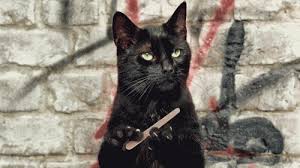Claw of the Cat, or How many Toes does a Cat have?
 This morning my partner came into my Study and said “Shandy keeps shedding his Claws” and handed me a tiny interesting claw sheath. I thought to myself “I wonder if that is normal” and “I wonder how much his claws are like our nails?” Upon reflection, I thought sensibly that cats in the wild need their claws for climbing, hunting and defence.
This morning my partner came into my Study and said “Shandy keeps shedding his Claws” and handed me a tiny interesting claw sheath. I thought to myself “I wonder if that is normal” and “I wonder how much his claws are like our nails?” Upon reflection, I thought sensibly that cats in the wild need their claws for climbing, hunting and defence.
I found the answers on THIS great page of Annie’s “Cat Talk 101” website. For example, cat’s claws have outer layers called “claw sheaths”, which shed or fall off every few months, leaving behind a nice new sharp claw. Cats don’t scratch to sharpen their claws, strictly speaking, but to get rid off the itchy old sheaths, which are the outer layer of their claws.
Some also say that cats scratch objects to calm themselves down and ease anxiety.
Apparently it is a myth that cats have got retractable claws. Their claws are projectile and retractile rather than retractable, meaning they can extend and lengthen or poke out their claws or tuck them in or shorten them but not really consciously completely pull them into their paw pads.
The Claw I looked at is really a sheath of a tiny claw, as the claws renew and the outer husks of the old claw are shed.
The online Encyclopaedia Britannica says the following.
Claw, also called Talon , narrow, arched structure that curves downward from the end of a digit in birds, reptiles, many mammals, and some amphibians. It is a hardened (keratinized) modification of the epidermis. Claws may be adapted for scratching, clutching, digging, or climbing. By analogy, the appendages of other lower animals are frequently called claws. The claw’s shape is ordinarily suited to the food-getting habit of the animal. Eagles have long, curved talons for grasping prey; the claws of chickens are short and sturdy, for scratching the ground for food.
There are two mammalian modifications of the claw: the nail and the hoof. A nail is a broad, flat claw on the upper surface of the digit. It is present in mammals, such as primates, that use their appendages for grasping. A hoof is a short, thick structure that surrounds the end of the digit. It is present in various forms in the ungulates, which have a reduced number of digits. Hoofs are an adaptation for running.
Below is a link to pictures from the Children’s EB showing so-called “retractable claws” in action.
http://kids.britannica.com/comptons/art-53056/All-cats-except-the-cheetah-have-retractable-claws
You can see the claw sheathed but with the tip or point of the sharp claw still out from the paw pad, which actually means technically speaking that the claw is not FULLY RECTRACTED or rectractible if this word means completely withdrawn and completely hidden.
I have noticed Shandy cat’s claws sticking out a tiny bit and wondered if his claws really are retractable. If you had a sharp Stanley Knife with a retractable blade, you would want the blade to be fully retracted into the tool when you store away the knife, not have a horribly sharp and dangerous tip sticking out even a little bit.
The difference between “retractable” and “retractile” is that a cat does not consciously stick out or tuck in its claws, as many people wrongly think. However, when kitty ( or a big cat ) is relaxed and at ease, like when it is sleeping on someone’s lap, or walking, the claws are partly tucked away within the paw, because the flexor tendons attached to the claws are relaxed, and thus the claws are pulled back. The tendons tauten to protrude the claw when a cat is alert or hunting, climbing or fighting.
However, I guess the kitty’s claws are withdrawn enough to describe them as retractable for most people.
Ligaments connect bone to bone, while tendons connect bone to muscle. The elastic ligament, pictured in red in the image above, pulls the distal phalanx close to the middle phalanx in order to keep the claws from touching the ground, working in tandem with the relaxed flexor tendon.
Cats walk on the tips and balls of their toes or “digits”. This is known as digitigrade walking. Each digit or toe has a claw, and there are usually five toes or digits on each cat forefoot and four on each hindfoot.
A cat’s and a dog’s paw pads are spongy pads of thick skin beneath each foot, assisting with silent movement and protecting the underlying bones and joints from injury during running and jumping. Digitigrade walking combined with pads and small feet helps a cat move silently.
If you want to read about claws and how they evolved into nails, when Primates came along, please click on THIS link to a Google book titled “Mammalogy: Adaptation, Diversity, Ecology”.
If you want to read about the hoofs or hooves of the “Ungulates”, please click on THIS link to “What is an Ungulate?”
By the way, DOGS do not have retractile or projectile claws, but they do walk on their toes, like cats. Their claws are always exposed, and make dogs well suited to running. Dogs run on their toes , and have four functional toes on both the front feet and the hind feet, and sometimes a fifth “dew claw” which serves no useful purpose, is not in contact with the ground, and is located higher on the inside of the leg.
You should NOT de-claw a Cat because that essentially means amputating part of her/his foot as opposed to trimming the claws. We leave Shandy be, and don’t even trim his claws. A dog’s claws become blunt with lots of walking on hard surfaces, so won’t need trimming usually.








Thanks for the great information. You might be interested to know (if you don’t already), that the number of claws/digits on cats seems to vary a bit. My cats (domestic shorthairs) have four front-facing claws and one dewclaw on each foot. I am told (but need to see firsthand) that Main Coons have five plus the dewclaw.
Hi David, thanks so much for your comment, I hardly get any Feedback, so it is especially appreciated. Welcome to Fascinating Animals.
I had an inkling that the Cats may vary with their “toes” but it is very interesting to me that your kitties have five digits on each foot, thank you for that !
I absolutely love Maine Coon cats and in fact a lady whom we took our Shandy cat to for looking after once, when we were going on Holiday, said she thought our Shandy had some Maine Coon cat in him. I will look out for the next Maine Coon and see if she / he will let me look at her / his feet. 🙂
If you would like your cats featured on this Blog under “Our Animal Friends” just do a comment here or on that Page, and I’ll get back to you as soon as I can. No need to publicly post your email contact, as I will see that “behind the scenes” when you fill in your Comment form.
Best wishes, Celine
Great info! You might like to see this, visible changes to cat anatomy – really helpful comparisons and radiographs from a vet on some of the changes that occur to a cat’s physiology after declawing are here, and very worth sharing – http://www.littlebigcat.com/declawing/physical-consequences-of-declawing/.
I also believe detrimental changes occur due to the inability to exercise muscles, so cats become unable to maintain their correct conformation, meaning declawing greatly impacts them over the long term.
Our own cat ended up with a slipped disc; she was declawed by mistake. We weren’t able to give informed consent because the vet didn’t disclose the nature of the surgery beforehand, leaving us shocked and feeling sick when we picked her up from the vet’s. This was before the internet existed, but the same concerns are still there because vets are either not aware or choose to ignore the consequences of amputating the last third of cats’ toes (some vets also do it to rabbits, dogs, Guinea pigs, and any other animals where it’s not illegal yet).
Two of our current rescued cats arrived already declawed, and both have deformed wrists, small shrunken toe pads with cracks and calluses, and hyperflexed, so they walk on toes at the wrong angle. One was never overweight and has such an odd, short gait with a hunched back. The other has dropped carpus (wrists) and recently started limping. Both had paw x-rays when their dentals were done, showing toes that are hyperflexed even when they are sedated.
If you watch “Tiger Island”, there’s an episode where skeletons of two old tigers were donated to a museum when they died of old age. They noted they looked like young cats without any signs of arthritis. They said they climbed telephone poles in their enclosures to retrieve their meat. What does that mean for our domestic cats?
Data: “Declawing and Science” puts to rest some myths but reveals surprising and disturbing facts – http://www.littlebigcat.com/declawing/declawing-and-science/
Hi Chris, thanks so much for your informative & interesting Comment. Sorry I took so long to approve it. I thought that I had changed the settings here so Comments were automatically approved, but must have done that for one of my other Blogs instead !! I do get lots of spam Comments on this Blog if I don’t set Comments to be moderated.
Anyhow I will look at the links as soon as I can. Thank you for caring for Cats, and for visiting my Blog.
Best wishes, Star Wise